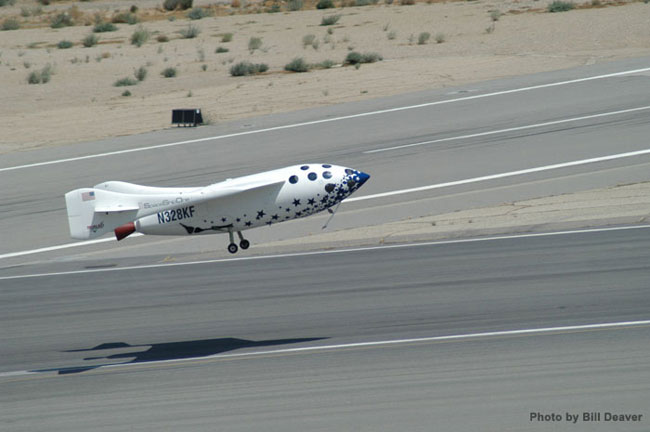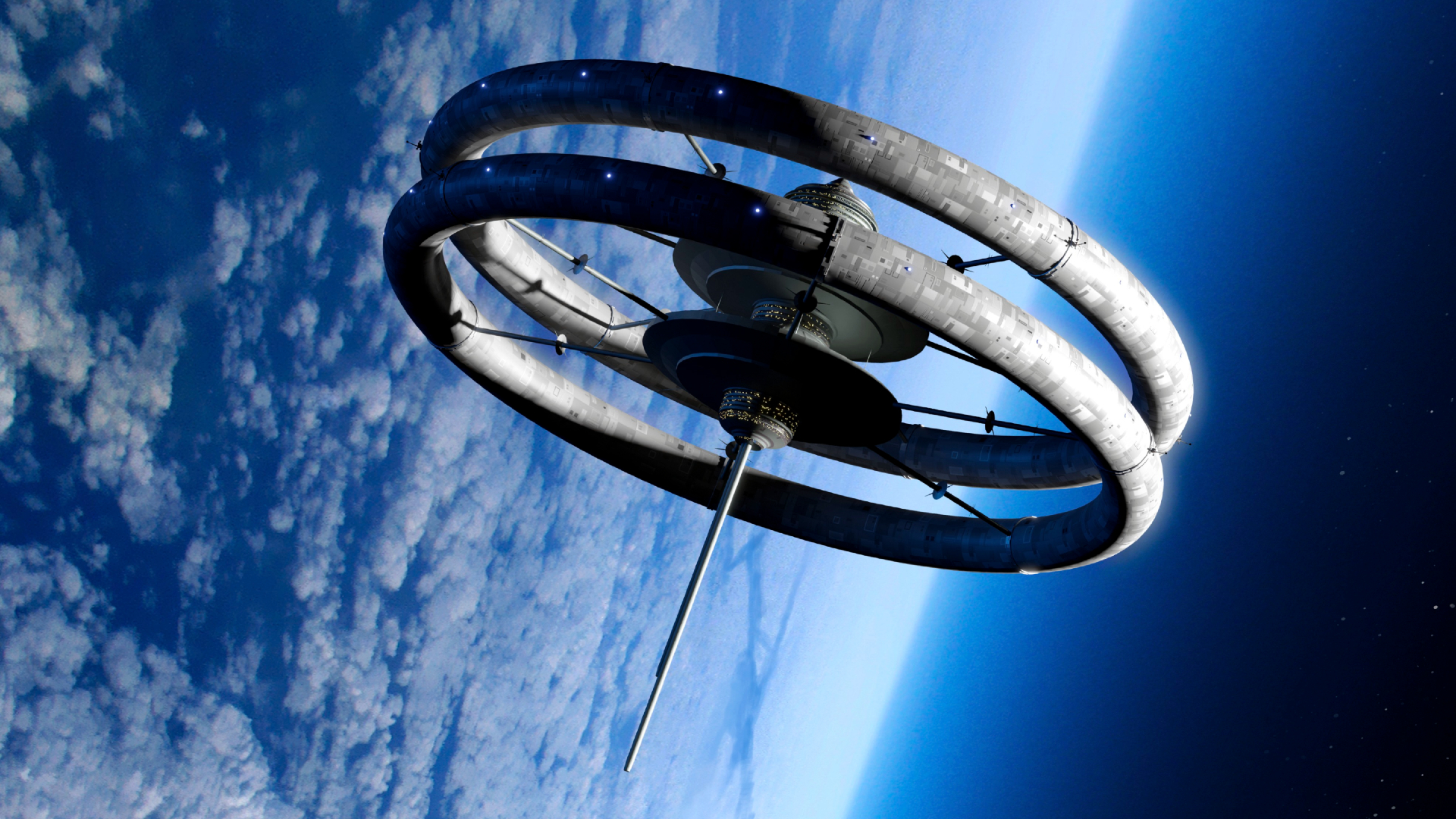5 Years After SpaceShipOne: Commercial Spaceflight Ready for 'Go'

It has beenfive years since SpaceShipOne screamed its way into the history books as thefirst privately built and financed manned craft to reach space. While that roarfrom the ship?s rocket engine has long since dissipated, the aftershocks fromits suborbital space shots are still being felt.
Roaring upwardover the Mojave, Calif., desert on repeat flights, pilots Mike Melvill and Brian Binnieindividually controlled the craft to the suborbital heights - and within thespan of a 14-day period. In doing so, on Oct. 4, 2004, the $10million Ansari X Prize was won - and the vision of non-governmental spaceflightbecame sharply focused.
Designed byMojave-based Burt Rutan - the lead out-of-the-box thinker of Scaled Compositesand his team - and financed by Microsoft co-founder Paul Allen, thebarrier-breaking vehicle earnedits stripes.
Its victorywas hailed by the banner: ?SpaceShipOne, Government Zero.?
Today, atthe Mojave Air and Space Port all appears in readiness for the combined testflights of WhiteKnightTwo and the sleek two-pilot, six-personSpaceShipTwo - the world?s first passenger-carrying suborbital spaceliner.This outing is backed by British entrepreneur, Sir Richard Branson and hisVirgin Galactic company. Like SpaceShipOne, the new SpaceShipTwo is designed tobe carried to a high altitude by a mothership aircraft where it can launch onsuborbital trips.
Abovethe fold
Burt Rutanreflects on the wake left by the pioneering SpaceShipOne flights, the winningof the Ansari X Prize, and a glimpse at the road ahead.
Breaking space news, the latest updates on rocket launches, skywatching events and more!
?Our big milestoneof 2004 occurred on June 21, the date of the first non-governmentmanned spaceflight. The X Prize flights were an opportunity for our sponsorand our employees to get a ?well-done bonus? and to show that our Juneaccomplishment was not a lucky fluke?that it really is feasible for low-costspace access to be offered to the public,? Rutan explained.
Rutanproudly spotlights a ?Google Trends? search that also shows the importance oftheir first manned spaceflight. The Newsworthy Record , that is the number ofworld newspapers that carried the story above the fold, showed that the June 21ststory was the second largest news event of 2004 - the first being the captureof Saddam Hussein. Three of the five manned space flights of 2004 were flownfrom Mojave, California.
?SpaceShipOne was my 39th manned aircraft type to be flight tested and wasclearly the most significant,? Rutan said. ?It was my last design?anopportunity to hand over the reins to the very talented young designers atScaled.?
Rutan saidthat he has continued to design new concepts as Chief Technology Officer andChairman Emeritus of Scaled Composites.
?I maydesign a future aircraft or two, but because of the rewarding experience ofSpaceShipOne for all my employees, I personally feel that my aircraftdevelopment career is complete,? Rutan told SPACE.com.
Historic,game changing
A witnessto all three of the SpaceShipOne flights was Will Whitehorn, President ofVirgin Galactic. ?Those breathtaking X Prize flights were worthy of everyclich? in the book?historic, game changing?all in all, the right stuff!?
WhenSpaceShipOne pilot Brian Binnie shot skyward on the second of back-to-backsuborbital treks to snag the X Prize purse, Whitehorn considered that historicday as ?one which will change the face of the space industry forever.?
And as the wispycontrail from that prize-winning run turned invisible, there were a host ofjudgments remaining, Whitehorn told SPACE.com. ?Big decisions had tofollow?such as whether to rebuild SpaceShipOne as a commercial vehicle, or takethe braver and more costly decision to build a truly capable integrated spacelaunch system,? he said.
Fastforward to the present: The WhiteKnightTwo/SpaceShipTwo is viewed as that spacelaunch system. The combo of flight hardware not only gives space tourists whatthey wanted, but also supports human-in-the-loop science and launchingsatellites as well, Whitehorn said.
?It is nowfive years on and where are we? Flying the launch vehicle?firing the rocketmotor?on the cusp of unveiling the finished SpaceShipTwo and of course watchinga runway unfold in the New Mexico desert,? Whitehorn added, pointing to thedevelopment of Spaceport America ? home base for Virgin Galactic commercialoperations.
?Hundredsof Virgin Galactic, Scaled and Spaceport America people are working towards atrue industrial revolution in space,? Whitehorn concluded. ?I, for one, can?twait, but will never forget the fact that the Ansari X prize was a realcatalyst for these events.?
Quietbefore the storm
?Right nowis the quiet before the storm,? said Rick Tumlinson, a leader in the NewSpacemovement and co-founder of the Space Frontier Foundation. He points to a trioof past events that has brought about the emerging space squall.
?The winning of the X Prize, the takeover of the Mir space station by privateinvestors and the flight of Dennis Tito to the space station were the threeshots that convinced investors that there was a market for commercial humanspaceflight, a way to capitalize on it in the near term?and people willing toput money into the idea,? Tumlinson said.
Comparing it to the moment before the flag is dropped on a race track, ?theteams are building their cars and rolling them out to the starting line,?Tumlinson said.
TheTumlinson timeline: Within the next few months the first companies will beginflights and within two years the first paying customers will be flying. Withinthree years the first commercial facilities will be overhead and within fiveyears you will be able to fly commercially to orbit on a private spaceship.
?NewSpacehas been through some major shakeouts, with only a few of the many firms survivingthat were around when the X Prize was won. In fact,
Scaled Composites may be the only one of the registered competitors that didsurvive,? Tumlinson said.
?It is important to maintain perspective. Some would have us believe that the XPrize all by itself signaled the NewSpace revolution. It did not,? he added. ?Therewere a lot of people working on a lot of important projects for at least adecade before it was won, and by itself it would not have been anything morethan a news blip.?
Tumlinsonsaid that beyond Scaled/Virgin Galactic, none of the other surviving NewSpacefirms that really have a chance to succeed competed for the X Prize at all.?XCOR and Armadillo Aerospace refused to participate, and the billionaire guyslike Bezos, Bigelow and Musk are doing their own thing completely,? he added.
New setof investors
PeterDiamandis, Chairman and Chief Executive Officer of the X Prize Foundation has adifferent take on the spark stemming from the X Prize.
?Since theAnsari X Prize was won in 2004, over $1 billion in capital has been investedinto the personal spaceflight industry,? Diamandis said. ?Of the 26 teams fromseven nations that competed, I would guess that about a quarter of them remainviable and are pushing toward commercial operations.?
In lookingback over the past five years, Diamandis said that one of the most importantresults of the Ansari X Prize involves credentialing this slice of the industryas real, as well as stimulating this market sector.
?People nowknow and believe that they can buy a private ticket to space without having tobe a government employee,? Diamandis noted. ?Other benefits include helping toclarify the regulatory regime and bringing a new set of investors and sponsorsto fund the entrepreneurs who have dedicated their lives to this industrysector.?
Claims,rhetoric, and drama
WhileSpaceShipOne?s snaring of the X Prize showcased the possible, as well as whatwas attainable, hubris shouldn?t be the propellant for pushing forward.
Thatcautionary view is espoused by David Livingston, the host of ?The Space Show?- a popular talkradio and streaming Internet program. On one hand, SpaceShipOne?s victory started opening a tightlyclosed door for investment which is opening even wider today.
?That said, accessing space is noteasy or dirt cheap - be it suborbital, orbital, or actually going someplace ratherthan just orbiting Earth,? Livingston said. ?While I believe the entrepreneursand businessmen and women know how to kick the door wideopen and establish needed space economic infrastructure to developthis new industry, I have my doubts about policy makers, our elected officials,and those motivated to hold on to old agendas that won?t work for the newspace economy.?
Livingston sees an increase in theclaims and rhetoric by enthusiasts, dreamers, advocates, and those wanting tobe very much a part of a truly space-faring world.
?The risk here is that asthe extremes in the claims, rhetoric, and drama get exposed to the lightof the day as being nothing more than what they are, they fuel the argumentsand unenlightened ways of those in power - or in influential positions -and they add to the risks of sidetracking or slowing down commercialspace development,? Livingston asserted.
The bottom line is that real spacedevelopment is essential for our future, Livingston said. ?Let?s keep itreal so we can achieve our goals and improve our world.?
- Image Gallery - SpaceShipOne?s X Prize-Winning Flight
- Special Reports: SpaceShipOne Soars to Space, Wins Ansari X Prize
- SPACE.com Video Show - Space X Prizes: Incentives to Orbit
LeonardDavid has been reporting on the space industry for more than four decades. Heis past editor-in-chief of the National Space Society's Ad Astra and SpaceWorld magazines and has written for SPACE.com since 1999.

Leonard David is an award-winning space journalist who has been reporting on space activities for more than 50 years. Currently writing as Space.com's Space Insider Columnist among his other projects, Leonard has authored numerous books on space exploration, Mars missions and more, with his latest being "Moon Rush: The New Space Race" published in 2019 by National Geographic. He also wrote "Mars: Our Future on the Red Planet" released in 2016 by National Geographic. Leonard has served as a correspondent for SpaceNews, Scientific American and Aerospace America for the AIAA. He has received many awards, including the first Ordway Award for Sustained Excellence in Spaceflight History in 2015 at the AAS Wernher von Braun Memorial Symposium. You can find out Leonard's latest project at his website and on Twitter.
